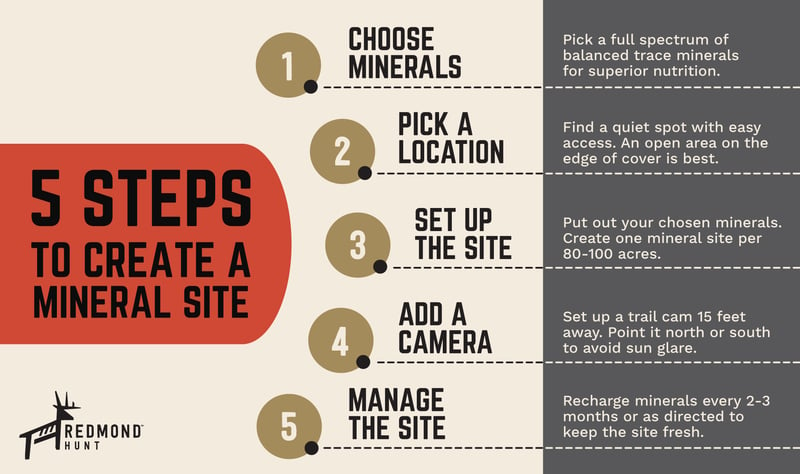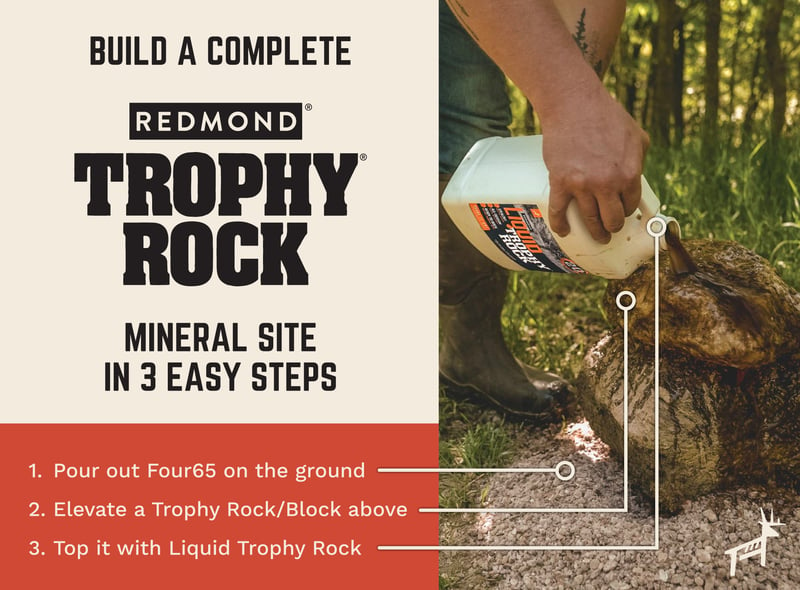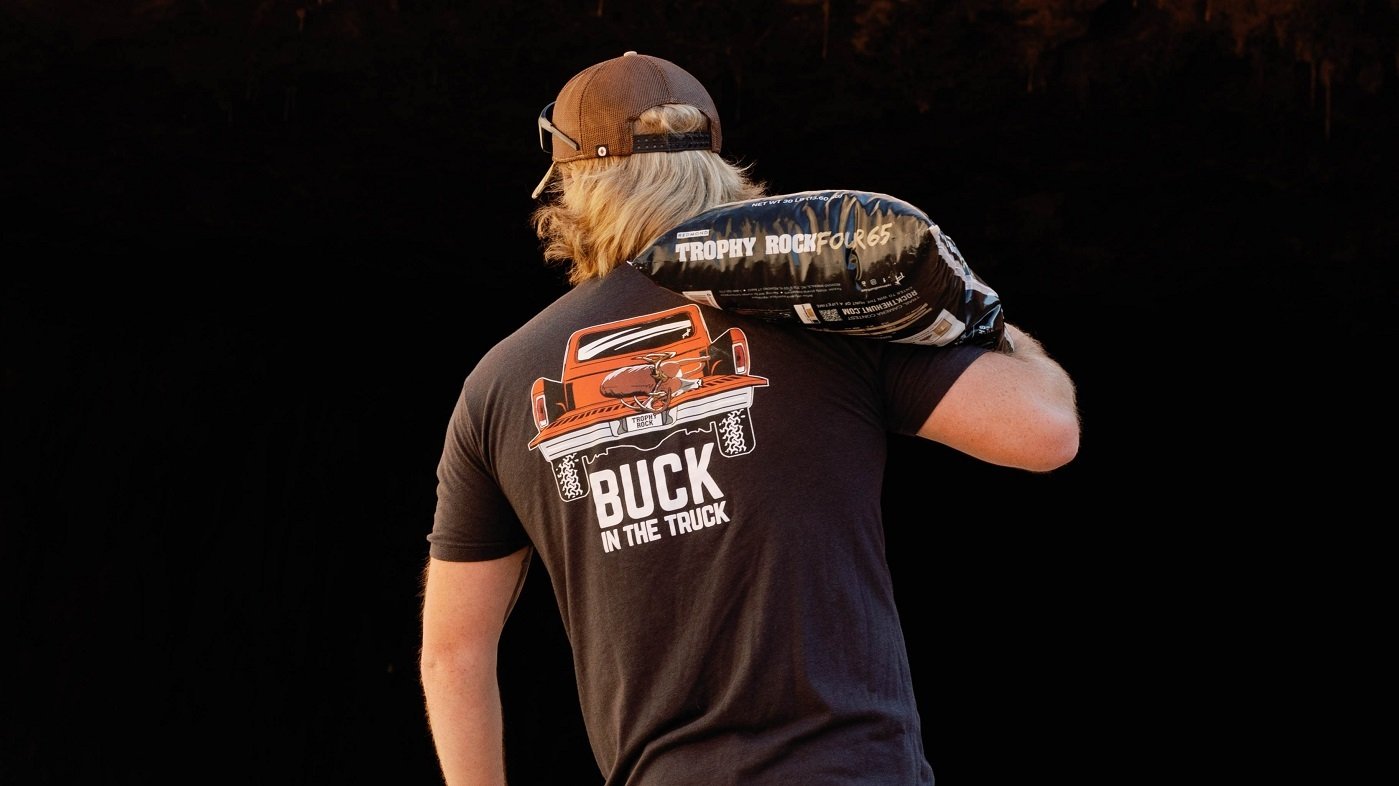Redmond Hunt Blog
How to Start a Deer Mineral Site that Delivers Results
Redmond Hunt April 12, 2023
Follow 5 steps to make your own deer mineral site. Also learn why deer crave salt and minerals, what minerals work best to attract deer, and where to put them.
It's that time of year again! Nature has finally put winter to bed and hunters are once again shedding cabin fever and heading back into the woods. Spring is the prime time to check out deer hunting grounds, set up mineral sites, and evaluate your herd's needs.
By March, deer are emerging from winter hungry and bucks are ready to grow their next big rack. So how can proactive hunters help? While spring green-up provides nutrients and protein-rich foods, it takes even more to rebuild herds. Setting out a quality deer mineral supplement can help you promote healthier deer, bigger bucks, and get better hunting results.
In this article, we’ll equip you with five easy steps to set up a mineral site, and discuss the best minerals to put out for deer. In no time, you’ll be owning your site like a pro. But first, let’s dive deeper into why deer need minerals and why it’s worthwhile for you to provide them.
Why a Mineral Site is Important
Deer are surrounded by minerals in the soil, water, forage, and trees on our lands. Unfortunately, however, erosion, runoff, and leaching often lead to mineral deficiencies in soil and plants. And since deer rely on the land for their nutrients, they often have the same deficits.
That's where you, supplying deer with an effective mineral site, come in. A mineral site is a great way to provide the nutrients lacking in deer’s natural diet, especially during March through August when bucks are in peak antler growth and does are supporting fetuses and nursing fawns. Access to balanced trace minerals during these life phases can help your herd and deliver these valuable benefits:
- Enhances antler growth potential
- Supports fetuses and healthy lactation
- Promotes healthier deer in the ranks
- Attracts deer to locations you choose
- Helps you scout deer using trail cameras
- Increases herd density on your property
5 Steps to Create a Mineral Site
Setting up a mineral site is easier than you may think. In just five simple steps, you can provide deer with essential minerals for optimal health and growth. (Before starting a site, check local regulations to ensure you meet any baiting or supplemental feeding restrictions.) Let's cover the steps and help you begin reaping the benefits for both your herd and hunting success.

1. Use Minerals Deer Need
Studies show calcium, phosphorous, copper, zinc, selenium, and sodium are critical for both bucks and does. Sodium chloride (salt) is especially important, as deer actively seek it out in spring to balance the high water content in green grasses. Their craving for salt also makes it an effective carrier to deliver other beneficial minerals deer need for optimum health.
You’ll typically find deer mineral salt supplements in three forms at outdoor retailers:
- Deer mineral rocks and blocks
- Loose or granular minerals
- Pourable liquid minerals
Every mineral site is unique, and which supplements work best for you, your herd, and property may be different from the hunter next door. The most important thing? Pick a quality product with balanced minerals that support deer during every season and life phase.
Redmond Hunt Deer Minerals
Whether you’re a weekend warrior or in it for the long haul, we have a Trophy Rock product to fit every hunter’s needs! Pick your preferred product below to own your mineral site and bring more deer to your trail camera and success to your hunts.
- Trophy Rock: For the choosy hunter who wants the original deer mineral lick. The Rock is a long-lasting visible mineral deer love, with proven results. Amazing product for inventory. Comes in 7-11 and 12-18 lb rocks.
- Trophy Rock Block: For the budget-conscious hunter looking for the best bang for the buck. Block is our 40-lb pressed block and longest-lasting visible mineral. The sweet candy apple scent offers long-range pull.
- Trophy Rock Four65: For the hunter creating a soil-based mineral lick. Four65 is a granular mineral that incorporates into the soil. It’s effective, easy to pour out, and budget friendly.
- Liquid Trophy Rock: For the weekend warrior wanting a powerful mineral attractant. Liquid is easy to use, discreet, and fast-acting. Helps you get in and hunt successfully without long-term commitment.

2. Where to Put Out Minerals for Deer
You’re now ready to choose a prime spot for your site. Because just throwing out a mineral product anywhere won't deliver the results you want! Success is all about location. So where should you put a deer mineral site? An area with good attraction potential and where deer feel safe and comfortable is the ticket.
These tips will help you pinpoint the perfect locale:
- Keep it off the beaten path. Choose a secluded location away from vehicle traffic but that’s easily accessible. A quick entry limits disturbance when visiting your site to recharge minerals or check your trail camera.
- Pick a spot where deer will find and use it. Opt for a small, open area on the edge of cover, such as a staging area, near deer bedding, food plots, or main trails.
- Make sure you can hunt over it. If you plan to harvest a buck in the fall at or near your site, ensure the location works for your hunting method.
Once you've determined where to put your site, keep it there! Mineral sites get better with age, and deer will use them year after year if they’re in good locations and deer know where to find them.
3. Set Up Your Deer Mineral Site
You've picked up your product and scouted your site. Now it's time to put out the minerals. Whether you're using a block or salt rock, granular minerals or liquid, make sure to follow the manufacturer's instructions for use.
Combining different forms of mineral products can also raise the bar and deliver sweet results. Ready to build the ultimate mineral site for maximum success? We’ve got you covered. Check out Redmond’s simple yet effective three-step program below to put out deer minerals and get your site rockin’.
- Pour out Trophy Rock Four65. Clear the ground of debris and pour a bag of Four65 granular minerals over a small area. The granules will incorporate into the soil with rain and become a mineral-dense lick.
- Add a Trophy Rock/Block above. Set your Trophy Rock or Block on a stump, stand, post, or another large rock above the granular minerals. Keeping the rock/block off the ground helps it last longer. Deer will also feel more relaxed licking it in a higher, less defensive posture.
-
Top it off with Liquid Trophy Rock. Pour desired amount of Liquid over your Trophy Rock/Block to quickly activate the site and draw deer from afar. Coat the entire mineral and immediate surrounding area with liquid for best results.
Quick Tip: So, just how many mineral sites for deer per acre should you have? One site per 80 acres of land is a reliable estimate. If you have a high deer density, consider establishing another site.

4. Monitor Your Mineral Site With a Trail Camera
This is where the real fun begins. Placing a trail camera at your mineral site provides great strategical information. Not only will you be able to confirm deer are actually visiting your site, but you can also track movement, monitor antler growth, catalog unique deer characteristics, and even catch a glimpse of that elusive buck you’ve been eyeing for fall.
Try these simple tricks for positioning your trail camera to capture visiting wildlife in its best light.
- Place the camera approximately 15 feet from your mineral site.
- Anchor it about four feet up a tree or at eye level with visiting deer.
- Face the camera north or south to avoid sun glare.
- Angle it towards woods to give photos a better backdrop.
5. Manage and Maintain the Site
Managing your site throughout the year (yes, minerals in winter are also important!) will provide valuable nutrition for deer and other wildlife for years to come. Your site will need some upkeep, though, to stay viable. Here are recommendations for replacing or refreshing Redmond minerals to maintain your site:
- Replace Trophy Rock/Block when it diminishes to the size of a softball.
- Recharge Four65 every three months with 30 to 50 pounds of mix.
- Top off your rock/block every two weeks or as desired to activate your site.
We advise against moving a mineral site if it’s not necessary, as most improve with age. If deer are hammering your site, that means they’re comfortable with its location and are relying on it for nutritional needs. Only consider relocating if you see a decline in activity, which could suggest deer patterns have changed or they've found a new nutritional source somewhere else. But as long as deer use your site, don't change it!
Get Out There and Own Your Site
Fist bump and congratulations! You're now equipped to create a mineral site on your land that will become a valuable hunting and herd management tool. Not only will you improve the nutrition of your whitetail population, but you'll also capture some incredible photos and be able to better monitor your herd's development.
Remember, to ensure a successful mineral site, choose a supplement that provides balanced minerals, select a strategic location, install a trail cam, and refresh the minerals as needed to keep the site active. Click below to check out natural Redmond Trophy Rock minerals and create your next successful site today!
© Redmond Hunt 2023. All rights reserved.



.jpg)
